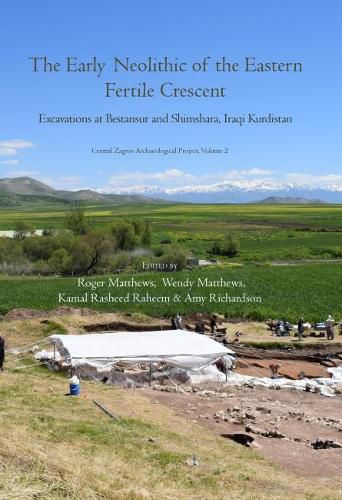Readings Newsletter
Become a Readings Member to make your shopping experience even easier.
Sign in or sign up for free!
You’re not far away from qualifying for FREE standard shipping within Australia
You’ve qualified for FREE standard shipping within Australia
The cart is loading…






The Eastern Fertile Crescent region of western Iran and eastern Iraq hosted major developments in the transition from hunter-forager to farmer-herder lifestyles through the Early Neolithic period, 10,000-7000 BC. Within the scope of the Central Zagros Archaeological Project, excavations have been conducted since 2012 at two Early Neolithic sites in the Kurdistan region of Iraq: Bestansur and Shimshara. Bestansur represents an early stage in the transition to sedentary, farming life, where the inhabitants pursued a mixed strategy of hunting, foraging, herding and cultivating, maximising the new opportunities afforded by the warmer, wetter climate of the Early Holocene. They also constructed substantial buildings of mudbrick, including a major building with a minimum of 65 human individuals, mainly infants, buried under its floor in association with hundreds of beads. These human remains provide new insights into mortuary practices, demography, diet and disease during the early stages of sedentarisation. The material culture of Bestansur and Shimshara is rich in imported items such as obsidian, carnelian and sea-shells, indicating the extent to which Early Neolithic communities were networked across the Eastern Fertile Crescent and beyond. This volume includes final reports by a large-scale interdisciplinary team on all aspects of the results from excavations at Bestansur and Shimshara, through application of state-of-the-art scientific techniques, methods and analyses. The net result is to re-emphasise the enormous significance of the Eastern Fertile Crescent in one of the most important episodes in human history: the Neolithic transition.
$9.00 standard shipping within Australia
FREE standard shipping within Australia for orders over $100.00
Express & International shipping calculated at checkout
The Eastern Fertile Crescent region of western Iran and eastern Iraq hosted major developments in the transition from hunter-forager to farmer-herder lifestyles through the Early Neolithic period, 10,000-7000 BC. Within the scope of the Central Zagros Archaeological Project, excavations have been conducted since 2012 at two Early Neolithic sites in the Kurdistan region of Iraq: Bestansur and Shimshara. Bestansur represents an early stage in the transition to sedentary, farming life, where the inhabitants pursued a mixed strategy of hunting, foraging, herding and cultivating, maximising the new opportunities afforded by the warmer, wetter climate of the Early Holocene. They also constructed substantial buildings of mudbrick, including a major building with a minimum of 65 human individuals, mainly infants, buried under its floor in association with hundreds of beads. These human remains provide new insights into mortuary practices, demography, diet and disease during the early stages of sedentarisation. The material culture of Bestansur and Shimshara is rich in imported items such as obsidian, carnelian and sea-shells, indicating the extent to which Early Neolithic communities were networked across the Eastern Fertile Crescent and beyond. This volume includes final reports by a large-scale interdisciplinary team on all aspects of the results from excavations at Bestansur and Shimshara, through application of state-of-the-art scientific techniques, methods and analyses. The net result is to re-emphasise the enormous significance of the Eastern Fertile Crescent in one of the most important episodes in human history: the Neolithic transition.